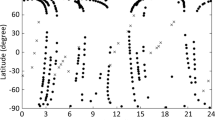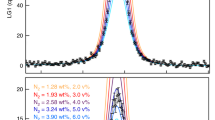Abstract
THE USSR Venera-4 probe entered the atmosphere of Venus on October 18, 1967, made the first direct measurements of the physico-chemical characteristics of the lower atmosphere and landed smoothly on the planet's surface1,2. The probe's whole descent took place on the night side of the planet, close to the equator and about 1,500 km from the terminator. The probe contained two resistance thermometers, an anaeroid barometer transducer, a densitometer and eleven core gas analysers. Immediately after the probe's parachutes opened at an altitude of 26 km, an atmospheric sample was inserted in five cores. The remaining six cores received samples at an altitude of 23 km. All the analysers operated. The carbon dioxide content turned out to be 90 per cent, with less than 10 per cent error. The water or moisture content turned out to be greater than 0.1 per cent and less than 0.7 per cent. In one analyser the oxygen content was greater than 0.4 per cent. In another analyser the oxygen and water content were less than 1.5 per cent, that is, the oxygen content is somewhere between 0.4–1.4 per cent. Finally, the nitrogen content is less than 7 per cent, for an analyser with this response showed no presence of nitrogen. Table 1, derived from these measurements, presents five atmospheres of differing composition for Venus, depending on the relative amounts of carbon dioxide, between the possible limits 80–99.5 per cent. Probably small quantities of argon and other inert gases are present in the atmosphere of Venus as may be deduced from the composition.
This is a preview of subscription content, access via your institution
Access options
Subscribe to this journal
Receive 51 print issues and online access
$199.00 per year
only $3.90 per issue
Buy this article
- Purchase on Springer Link
- Instant access to full article PDF
Prices may be subject to local taxes which are calculated during checkout
Similar content being viewed by others
References
Pravda, No. 295 (17977), 6 (October 22, 1967).
Vinogradov, A., Izvestiia, No. 257 (15651, October 31, 1967).
Koenig, L., Murray, F., Michaux, C., and Hyatt, H., Handbook of the Physical Properties of the Planet Venus, NASA SP-3029 (1967).
Hilsenrath, J., Tables of the Thermodynamic and Transport Properties of Air, Argon, Carbon Dioxide, Carbon Monoxide, Nitrogen, Oxygen, and Steam (Permagon Press, New York, 1960).
Kennard, E. H., Kinetic Theory of Gases, 265 (McGraw-Hill Book Co., New York, 1938).
Davidson, G. T., and Anderson, A. D., Science, 156, 1729 (1967).
Author information
Authors and Affiliations
Rights and permissions
About this article
Cite this article
ANDERSON, A. Superadiabatic Atmospheric Layer on Venus, as inferred from the Venera-4 Probe Measurements. Nature 217, 627–628 (1968). https://doi.org/10.1038/217627a0
Received:
Revised:
Issue Date:
DOI: https://doi.org/10.1038/217627a0
Comments
By submitting a comment you agree to abide by our Terms and Community Guidelines. If you find something abusive or that does not comply with our terms or guidelines please flag it as inappropriate.



